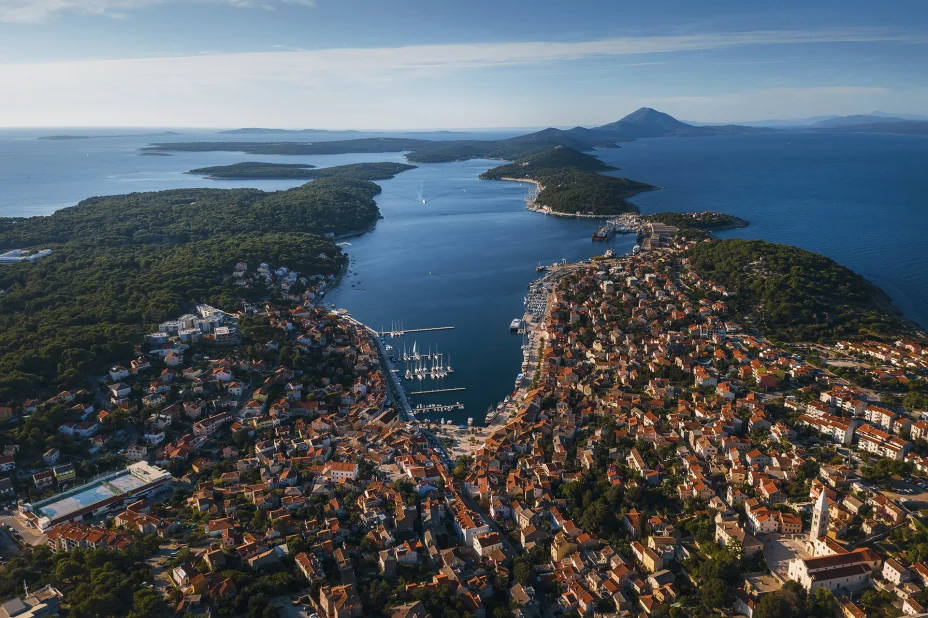Welcome to a fragrant, Mediterranean garden enveloped by the sea! Lošinj Island is worthy of the moniker Island of Vitality. With over 200 sunny days a year, around 1200 different plant species and the surrounding crystal-clear sea, our island is the perfect destination for pure enjoyment and recharging.
Lošinj is a part of the Cres-Lošinj archipelago in Kvarner Bay in the northern Adriatic.
If you come to Lošinj by land, you will have to cross as many as two islands. But once there you will get more than you bargained for. Here you will find your happy place.
Climate in Lošinj
The mild Mediterranean climate of Lošinj, with a high level of humidity and clement temperatures in summer and winter (warm summers and mild winters) has a beneficial effect on health. The island abounds in aromatic herbs such as lavender, rosemary and immortelle. Compounded with sea droplets and the scent of the pine forest, the air on the island has a therapeutic and healing effect.
Lošinj is also historically famous for its 125-year-long tradition of spa tourism, in which monarchs and the aristocracy would indulge and which can be traced back to the period of Austria-Hungary.
Summers are warm and winters are mild and humid, with temperatures rarely dropping below zero. It seldom snows on the island. The temperate autumn and spring, when conditions are the most favourable for an activity holiday, make Lošinj a sought-after destination throughout the year.
Lošinj through history
The Cres-Lošinj archipelago was discovered by humans a long time ago. There is a legend surrounding the origin of Apsyrtides, the joint name of the archipelago in ancient times. It was named after the Greek hero Apsyrtus from the legendary story of the Argonauts, sailors from the ship Argo who accompanied Jason on his quest for the Golden Fleece in the years leading up to the Trojan War. Jason discovered the Golden Fleece in Colchis, on the present-day Black Sea coast in the Caucasus. But there he also found the love of his life, Medea, who was the daughter of the King of Colchis. Medea aided him in stealing the fleece, which displeased the Olympian gods who sent a furious storm upon them that hindered their journey. Fleeing from their pursuers, they reached Istria, where they put the ship on their shoulders and carried it to the sea, in Kvarner, and resumed their escape. Jason faced Medea’s brother Apsyrtus in northern Kvarner and vanquished him in an epic battle, then dismembered and cast him into the sea. The Cres-Lošinj archipelago was fashioned from Apsyrtus’ body.
In the Bronze Age, developed Mediterranean cultures took the so-called Amber Road, which was a historical route by which precious amber (the fossilized resin of coniferous trees) was transported from the Baltic to the Mediterranean. Due to its simple processing and beauty, amber has been used to make jewellery since the Palaeolithic, and it was also believed that it possessed medicinal and even supernatural properties, such as the power to attract good and ward off evil.
Osor was an important station on the Amber Road. This is evidenced by numerous amber findings in Illyrian graves near Osor.
The Amber Road also cut through the northern Adriatic, which can be deduced by the remains of jewellery and amber balls from the Iron Age that were found in this area.
There are remains of old herding structures abandoned during the Roman Empire on the hills on Lošinj. Lopari was the first settlement established in that time.
There was no organized government after the fall of the Roman Empire, piracy was rampant and the island was only inhabited by sheep in the Middle Ages. Lošinj was governed by the town of Osor, whose inhabitants also named the fields surrounding Nerezine. It was no coincidence that this area was ruled by a roundabout of governments, such as the Byzantine Empire, the Republic of Venice and the Habsburg Monarchy. The island’s favourable geographical location was paramount for the development of seafaring and trade.
The inhabitants were employed in shipbuilding and fishing, which were crucial for the island’s economic development.
The town of Mali Lošinj began to develop in the 19th century. Today it is the largest settlement on the island. As early as in the 19th century, Lošinj was acknowledged as the perfect destination for spa tourism, which it has remained until the present day.










